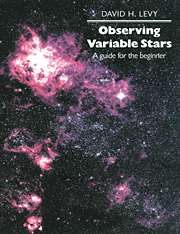Book contents
- Front Matter
- Contents
- Foreword
- Opening thoughts
- Acknowledgments
- Part 1 Getting to know the sky
- Part 2 Getting to know the variables
- 5 Meeting the family
- 6 Getting started with Cepheids
- 7 Algol, the demon of autumn
- 8 How to estimate a variable
- 9 Names and records
- 10 Observing hints
- 11 Stately and wonderful
- 12 Stars of challenge
- 13 Bright, easy, and interesting
- 14 Betelgeuse: easy and hard
- 15 Not too regular
- 16 Nova? What Nova?
- 17 Supernovae
- 18 Three stars for all seasons
- 19 A nova in reverse?
- 20 RU Lupi?
- 21 Orion, the star factory
- 22 Other variable things
- 23 The Sun
- Part 3 Suggested variables for observation throughout the year
- Part 4 A miscellany
- Index
17 - Supernovae
Published online by Cambridge University Press: 22 September 2009
- Front Matter
- Contents
- Foreword
- Opening thoughts
- Acknowledgments
- Part 1 Getting to know the sky
- Part 2 Getting to know the variables
- 5 Meeting the family
- 6 Getting started with Cepheids
- 7 Algol, the demon of autumn
- 8 How to estimate a variable
- 9 Names and records
- 10 Observing hints
- 11 Stately and wonderful
- 12 Stars of challenge
- 13 Bright, easy, and interesting
- 14 Betelgeuse: easy and hard
- 15 Not too regular
- 16 Nova? What Nova?
- 17 Supernovae
- 18 Three stars for all seasons
- 19 A nova in reverse?
- 20 RU Lupi?
- 21 Orion, the star factory
- 22 Other variable things
- 23 The Sun
- Part 3 Suggested variables for observation throughout the year
- Part 4 A miscellany
- Index
Summary
There is something magical about a star that, in its final phase of life, announces its end to the entire Universe. On July 4, 1054, Chinese skywatchers were stunned by something new in the sky. The “guest star” they reported was the outburst of a supernova, triggered by a major instability and collapse within the star. Since then at least three other supernovae have been easily visible from Earth, in 1572 and 1604, a time when European civilization was just about ready to accept new thoughts on the stability and arrangement of stars in space, and in 1987, when our understanding of the process of a supernova was finally good enough to be tested.
In 1054, native American records consisting of paintings and carvings on rocks welcomed a bright new star in Taurus. More accurate Chinese records have given us information so that we can pinpoint the date of the event as July 4, 1054. Much brighter than nearby Aldebaran, the exploding star could be visible in daylight.
- Type
- Chapter
- Information
- Observing Variable StarsA Guide for the Beginner, pp. 73 - 79Publisher: Cambridge University PressPrint publication year: 1989

